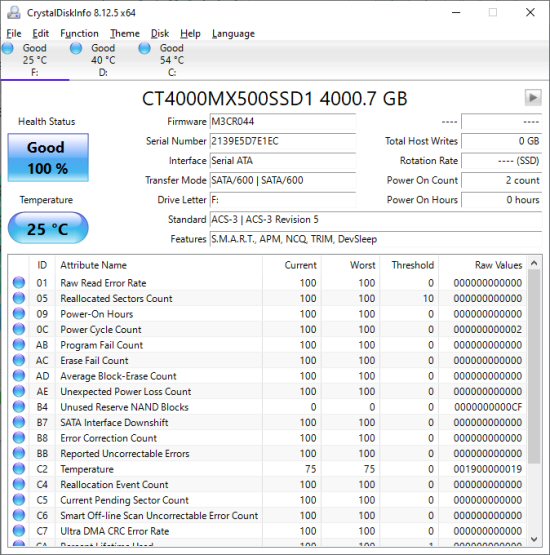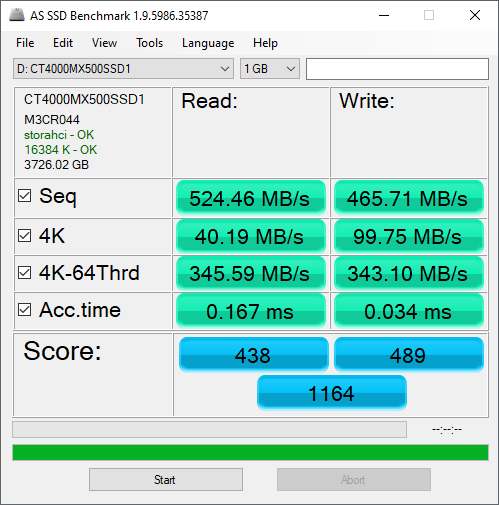TRIM Performance:
While SSD's offer many benefits, there are some downsides to using flash memory. One of the biggest issues people run into is performance degradation. Over time, an SSD will run out of fresh blocks and will have to write over data the file system has marked as deleted. This procedure is very complicated and can slow an SSD's write speeds considerably.
To fix this problem, most manufacturers have added TRIM support to their SSDs. The TRIM command allows an operating system, such as Windows 10, to tell an SSD which data blocks are no longer in use. Using this information, the drive pro-actively erases these blocks and adds them to the free block pool.

To test the MX500's TRIM and garbage collection functions, I first put the drive in a "dirty" state. I used Iometer to fill 80% of the drive and then ran a random write test for about 45 minutes. This had little impact on the MX500's read speed. However, its average writing speed dropped to 235.75 MB/s.

Crucial MX500 - Dirty
To see how well the MX500 could recover, I let the computer sit for about 30 minutes and then reran the test. The drive wasn't able to reach the factory fresh performance shown in our earlier tests. However, its sequential write speed jumped up to 465.71 MB/s.

Crucial MX500 - After TRIM
Lastly, I used Parted Magic to perform a secure erase on the MX500. With the drive wiped clean, it had average read and write speeds of 524.82 MB/s and 491.59 MB/s, respectively.

Crucial MX500 - Secure Erased
Final Thoughts:
Crucial's MX500 SSD has been around for a number of years now and, while some may see it as being a bit long in the tooth, it remains one of the best SATA drives on the market today. The new 4TB version of the MX500 is no exception. Powered by Silicon Motion's SM2259 controller, this high-capacity drive uses Micron's latest 176-layer 3D TLC NAND flash to deliver good performance, enhanced features and a high level of endurance at a competitive price. In our sequential read and write tests, the 4TB version of the MX500 was able to read at speeds as high as 564 MB/s and write at speeds in excess of 515 MB/s. It also did fairly well in our random write tests, producing more than 78,000 IOPS at low queue depths.
Of course, performance and capacity aren't the only things the MX500 has to offer. Along with thermal and power loss protection, TRIM support and active garbage collection, the drive features AES 256-bit full disk encryption and is compatible with both the TCG Opal and IEEE 1667 specifications. The MX500 also uses Dynamic Write Acceleration to enable faster saves and file transfers, and technologies like Data Defense and Redundant Array of Independent NAND (RAIN) to protect data at the component level and prevent it from becoming corrupted. Last, but not least, the MX500 supports the SATA Device Sleep (DEVSLP) standard which extends the battery life of a device by reducing the drive's power consumption when it's not in use.
The Crucial MX500 is available now in 250GB, 500GB, 1TB, 2TB and 4TB capacities. Prices on Amazon.com currently range from $50 up to $360 for the 4TB version reviewed here.

Highs:
- Silicon Motion 2259 controller
- Micron 176-layer 3D TLC NAND
- Good sequential and random read and write performance
- Dynamic Write Acceleration, Data Defense and RAIN technologies
- AES 256-bit full disk encryption
- TCG Opal and IEEE 1667 compliant
- DEVSLP power mode
- Supports TRIM, SMART and active garbage collection
- Thermal and power loss protection
- Ultra-slim form factor
- Works with Crucial's Storage Executive software
- Includes 9.5mm spacer and data migration software
- 5 year warranty
- Reasonably priced
Lows:
- Write speed drops when SLC cache is full

